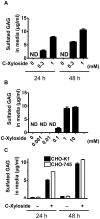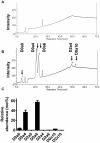Exogenous addition of a C-xylopyranoside derivative stimulates keratinocyte dermatan sulfate synthesis and promotes migration
- PMID: 21998662
- PMCID: PMC3187761
- DOI: 10.1371/journal.pone.0025480
Exogenous addition of a C-xylopyranoside derivative stimulates keratinocyte dermatan sulfate synthesis and promotes migration
Abstract
As C-Xyloside has been suggested to be an initiator of glycosaminoglycan (GAG) synthesis, and GAGs such as Dermatan sulfate (DS) are potent enhancers of fibroblast growth factor (FGF)--10 action, we investigated if a C-Xylopyranoside derivative, (C-β-D-xylopyranoside-2-hydroxy-propane, C-Xyloside), could promote DS production by cultured normal human keratinocytes, how this occurs and if C-Xyloside could also stimulate FGF-dependent cell migration and proliferation. C-Xyloside-treated keratinocytes greatly increased secretion of total sulfated GAGs. Majority of the induced GAG was chondroitin sulfate/dermatan sulfate (CS/DS) of which the major secreted GAG was DS. Cells lacking xylosyltransferase enzymatic activity demonstrated that C-Xyloside was able to stimulate GAG synthesis without addition to core proteins. Consistent with the observed increase in DS, keratinocytes treated with C-Xyloside showed enhanced migration in response to FGF-10 and secreted into their culture media GAGs that promoted FGF-10-dependent cellular proliferation. These results indicate that C-Xyloside may enhance epithelial repair by serving as an initiator of DS synthesis.
Conflict of interest statement
Figures




Similar articles
-
Chondroitin sulfate proteoglycan synthesis and reutilization of beta-D-xyloside-initiated chondroitin/dermatan sulfate glycosaminoglycans in fetal kidney branching morphogenesis.Dev Biol. 1989 Jun;133(2):515-28. doi: 10.1016/0012-1606(89)90054-7. Dev Biol. 1989. PMID: 2499495
-
Xyloside-primed Chondroitin Sulfate/Dermatan Sulfate from Breast Carcinoma Cells with a Defined Disaccharide Composition Has Cytotoxic Effects in Vitro.J Biol Chem. 2016 Jul 8;291(28):14871-82. doi: 10.1074/jbc.M116.716829. Epub 2016 May 12. J Biol Chem. 2016. PMID: 27226567 Free PMC article.
-
Heparan/chondroitin/dermatan sulfate primer 2-(6-hydroxynaphthyl)-O-beta-D-xylopyranoside preferentially inhibits growth of transformed cells.Cancer Res. 1998 Mar 15;58(6):1099-104. Cancer Res. 1998. PMID: 9515787
-
Sugar-coating wound repair: a review of FGF-10 and dermatan sulfate in wound healing and their potential application in burn wounds.J Burn Care Res. 2012 May-Jun;33(3):299-310. doi: 10.1097/BCR.0b013e318240540a. J Burn Care Res. 2012. PMID: 22561305 Free PMC article. Review.
-
Implementation of infrared and Raman modalities for glycosaminoglycan characterization in complex systems.Glycoconj J. 2017 Jun;34(3):309-323. doi: 10.1007/s10719-016-9743-6. Epub 2016 Dec 7. Glycoconj J. 2017. PMID: 27928742 Free PMC article. Review.
Cited by
-
Probing the acceptor active site organization of the human recombinant β1,4-galactosyltransferase 7 and design of xyloside-based inhibitors.J Biol Chem. 2015 Mar 20;290(12):7658-70. doi: 10.1074/jbc.M114.628123. Epub 2015 Jan 7. J Biol Chem. 2015. PMID: 25568325 Free PMC article.
-
Glycosaminoglycans: Sweet as Sugar Targets for Topical Skin Anti-Aging.Clin Cosmet Investig Dermatol. 2021 Sep 14;14:1227-1246. doi: 10.2147/CCID.S328671. eCollection 2021. Clin Cosmet Investig Dermatol. 2021. PMID: 34548803 Free PMC article. Review.
-
A novel cytoskeletal action of xylosides.PLoS One. 2022 Jun 28;17(6):e0269972. doi: 10.1371/journal.pone.0269972. eCollection 2022. PLoS One. 2022. PMID: 35763520 Free PMC article.
-
Propolis induces chondroitin/dermatan sulphate and hyaluronic Acid accumulation in the skin of burned wound.Evid Based Complement Alternat Med. 2013;2013:290675. doi: 10.1155/2013/290675. Epub 2013 Mar 7. Evid Based Complement Alternat Med. 2013. PMID: 23533471 Free PMC article.
-
The role of the extracellular matrix components in cutaneous wound healing.Biomed Res Int. 2014;2014:747584. doi: 10.1155/2014/747584. Epub 2014 Mar 17. Biomed Res Int. 2014. PMID: 24772435 Free PMC article. Review.
References
-
- Penc SF, Pomahac B, Winkler T, Dorschner RA, Eriksson E, et al. Dermatan sulfate released after injury is a potent promoter of fibroblast growth factor-2 function. J Biol Chem. 1998;273:28116–28121. - PubMed
-
- Taylor KR, Rudisill JA, Gallo RL. Structural and sequence motifs in dermatan sulfate for promoting fibroblast growth factor-2 (FGF-2) and FGF-7 activity. J Biol Chem. 2005;280:5300–5306. - PubMed
-
- Ashikari S, Habuchi H, Kimata K. Characterization of heparan sulfate oligosaccharides that bind to hepatocyte growth factor. J Biol Chem. 1995;270:29586–29593. - PubMed
-
- Lyon M, Deakin JA, Rahmoune H, Fernig DG, Nakamura T, et al. Hepatocyte growth factor/scatter factor binds with high affinity to dermatan sulfate. J Biol Chem. 1998;273:271–278. - PubMed
-
- Maccarana M, Casu B, Lindahl U. Minimal sequence in heparin/heparan sulfate required for binding of basic fibroblast growth factor. J Biol Chem. 1993;268:23898–23905. - PubMed
Publication types
MeSH terms
Substances
Grants and funding
LinkOut - more resources
Full Text Sources
Research Materials

